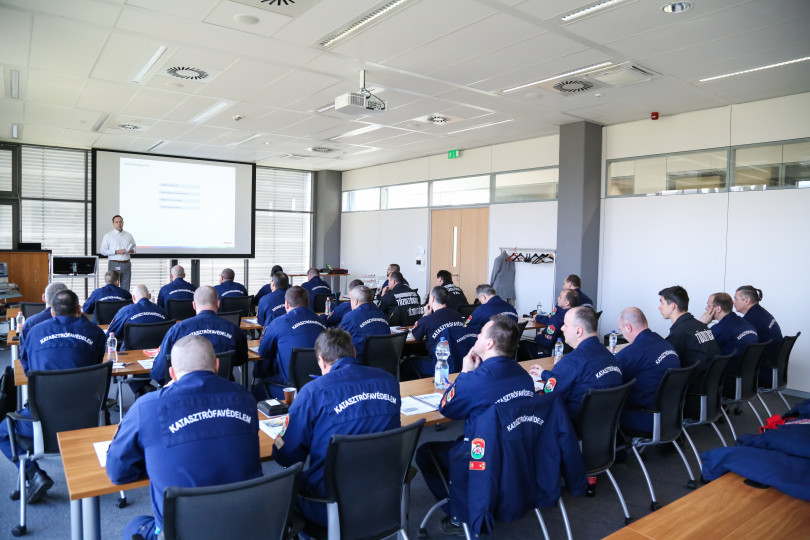Bosch and the National Disaster Management Directorate (OKF) started working last year on a collaborative project in which database software previously used solely in Bosch service garages is being put to use in the emergency services’ control center. When rescuing injured people after a road accident, it is vital for the emergency services to know the technical parameters of the vehicle, particularly the precise location of the battery, because isolating the electrical system to prevent electric shock is the first step in the rescue operation. That is what the software will do in its new area of operation, and it could save lives at an accident scene. In recent months, Bosch has provided free training on the use of the program for 600 firefighters nationwide.
The ESI[tronic] 2.0 system now being provided to the emergency services was originally developed for repair and diagnostics, and no automotive manufacturer has a comparable comprehensive database. It allows precise technical information on more than 95 percent of the cars and commercial vehicles currently on the roads to be retrieved within seconds, and data on new models becomes available within six months after they go on to the market. For firefighters arriving at the scene of an accident, the exact location of the battery is the most important information, allowing them to isolate the electrical system. A complicating factor during rescue is that the batteries of today’s cars are not always installed in the engine compartment. They can be in various different places, and some cars have more than one battery. The up-to-date and immediately-retrievably information in the Bosch database is thus very important, because the injured people in the damaged car can only start after the power has been disconnected.
Bosch is a key player in transport safety developments
Advanced countries have introduced many new measures in recent years to reduce the number of fatalities in road accidents. Bosch has played a key role in these advances: an example of one of its many road safety developments is the ABS system, first demonstrated by Bosch in 1978 and now found in every car.
Javier González Pareja, representative of the Bosch Group in Hungary, said, “With long experience in the automotive industry and a knowledge base that covers all vehicles on the market, Bosch has the capability to assist the emergency services in starting rescue work as quickly as possible following an accident or a disaster. Bosch is now providing valuable assistance through software that contains the technical parameters of nearly the entire spectrum of vehicles currently on the roads and contains data that can identify the battery and airbag control units, data that is of key importance in accident rescue.”
Dr Tibor Tollár, Director General of the OKF, said, “Last year, the fire brigade had nearly 60,000 callouts, of which more than half involved technical rescue. No two accidents are alike, and firefighters have to have the highest level of training possible, and must be provided modern equipment and services to increase their effectiveness.” He added that there are an average of 6000 road accidents in Hungary each year, and an exact knowledge of vehicles’ technical parameters could significantly speed up intervention and thus save lives.
Mónika Hack
+36 70 510 5516
Bosch has been present in Hungary since 1899. After its re-establishment as a regional trading company in 1991, Bosch has grown into one of Hungary’s largest foreign industrial employers. In fiscal 2015, its nine Hungarian subsidiaries had a total turnover of HUF 959 billion and sales of the Bosch Group on the Hungarian market – not counting trade among its own companies – was HUF 246 billion. The Bosch Group in Hungary employs some 12,200 people (as per January 1, 2016). In addition to its manufacturing, commercial and development business, Bosch has a network of sales and service operations that covers the entire country.
The Bosch Group is a leading global supplier of technology and services. It employs roughly 375,000 associates worldwide (as of December 31, 2015). The company generated sales of 70.6 billion euros in 2015. Its operations are divided into four business sectors: Mobility Solutions, Industrial Technology, Consumer Goods, and Energy and Building Technology. The Bosch Group comprises Robert Bosch GmbH and its roughly 440 subsidiaries and regional companies in some 60 countries. Including sales and service partners, Bosch’s global manufacturing and sales network covers some 150 countries. The basis for the company’s future growth is its innovative strength. Bosch employs 55,800 associates in research and development at 118 locations across the globe. The Bosch Group’s strategic objective is to deliver innovations for a connected life. Bosch improves quality of life worldwide with products and services that are innovative and spark enthusiasm. In short, Bosch creates technology that is “Invented for life.”
Additional information is available online at www.bosch.hu











